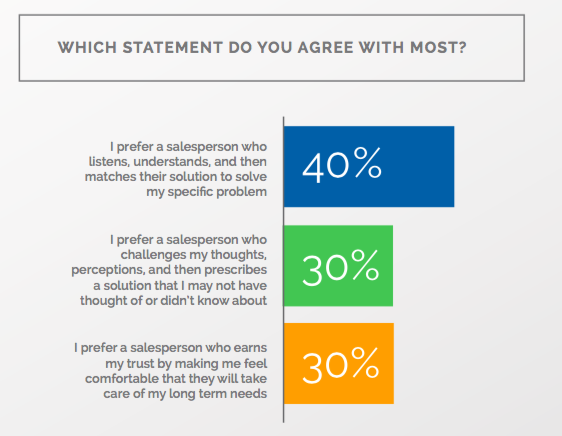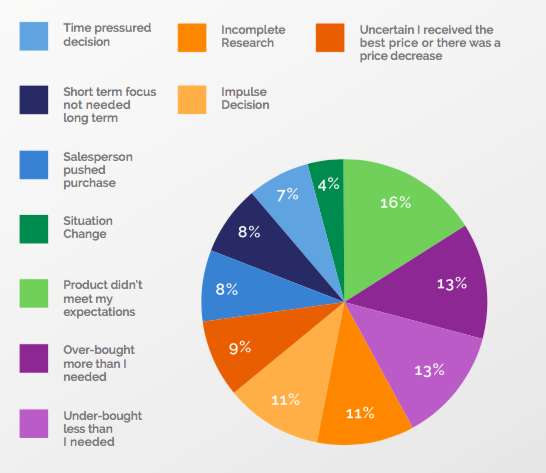B2B
Study: B2B Buyers Aren’t Too Happy With Salespeople
Salespeople don’t have it easy. Hit your numbers and you’re safe. Miss your sales quota, and you may be looking for work. That reality puts salespeople in an awkward position. They have to push products to anyone with a pulse, yet no one wants to buy from a pushy salesperson.
According to a recent study from DiscoverOrg, a sales intelligence platform, not many B2B salespeople are successfully walking this tightrope. The company, along with researcher Steve W. Martin, surveyed more than 230 decision-makers across industries and departments about their experience with B2B sales processes.
Judging by the results, one takeaway is clear: Buyers aren’t happy with B2B salespeople. Overall, only 35 percent of buyers have a “favorable view” of salespeople. And only 54 percent said that salespeople they met with could “clearly explain how their solution positively impacts” their business.

Interestingly, approval levels change dramatically depending on whom you ask. Departments that are more risk-averse—such as accounting, engineering, and IT—were much more likely to rate salespeople as “poor” than marketing departments.
The report wasn’t all bad news for salespeople, however. Let’s take a look at a few other takeaways marketers and salespeople should know.
Sell to the “dominant influencer”
When dealing with a large organization or a complicated deal process, salespeople can get caught up trying to please everyone they meet. But DiscoverOrg’s research shows that about 90 percent of the time, you really only need to convince one decision-maker. If you get that person on your side, closing the deal becomes much easier.

Savvy salespeople know this already, but it bears repeating since they’re still going to communicate with multiple people during any sales process. Hone in on finding and convincing the person controlling the decision, don’t turn off everyone else, and you’ll set yourself up for success.
Cost tops functionality (most of the time)
One of the reasons B2B companies constantly strive to be market leaders is to simplify the sales process. Once a brand dominates all of its competition, the “market leader” label implies legitimacy and success. For salespeople, throwing around that phrase is supposed to make it easier to sell.
In the study, however, market leadership is only part of the buyer’s equation. Of course, there’s also cost, which can matter more than you think. For instance, 62 percent of respondents said instead of paying top dollar, they would rather buy a product with “85 percent of the functionality at 80 percent of the cost” of a top brand.

These preferences can vary depending on the industry. Prestige companies that charge a lot tend to appeal to the fashion and finance verticals, while industries like healthcare and manufacturing are less enamored by the big names.

Buyers like different styles
There are different ways for salespeople to approach a prospect. Some like to get to know the buyer and tailor the sale to specific needs. Others like to be more assertive, pushing their vision of what they think the buyer needs. Some may even present themselves as advisors, ensuring that they’re committed to helping the customer in any way possible.

According to the research, there is no “right” way to approach a buyer. Forty percent prefer a salesperson who listens and matches to need, 30 percent prefer to be challenged and prescribed, and 30 percent like when salespeople operate as a long-term partner. If you’re a salesperson, that means it’s critical to find out which approach the buyer prefers as quickly as possible.
Your website is really important
No one buys a product without doing research, especially in the B2B space. The first place people go is often your website—and DiscoverOrg’s research shows that it’s an extremely influential part of the buying process.

Only 2 percent of buyers said that a company’s website doesn’t influence their vendor evaluation. If it wasn’t obvious before, B2B marketing teams should always make their websites a priority by doing things like refreshing copy, updating design, and checking for broken links.
Buyer’s remorse isn’t usually the salesperson’s fault
Buyer’s remorse can happen in every sales situation, but it can be particularly painful in B2B. Someone buys an expensive product, then something goes wrong. Perhaps they misunderstood the product, didn’t buy the right features, struggle using it, and so on.
Whatever the reason, 90 percent of respondents claimed their remorse had nothing to do with the salesperson. Instead, it’s often the buyer who made a mistake with research or implementation. Additionally, the product or customer teams can also be at fault for not helping buyers succeed with whatever they purchased.

The data should serve as an important reminder that a lot of the stakes in B2B sales go beyond the scope of the salesperson. For a customer to get value out of a product, a lot of things have to go right, many of which are out of the salesperson’s control. It’s hard to sell a product that doesn’t match up to its messaging, and it’s even harder to make sure that a customer actually puts in the time to use a product correctly.
So perhaps B2B buyers aren’t as displeased with salespeople as they are displeased with the complicated process of purchasing B2B products. Either way, there are a lot of things marketers and salespeople can do to make that 35 percent approval rating rise in the future. And once they do, maybe their jobs will finally get a little easier.
Image by Pexels / CC ZeroGet better at your job right now.
Read our monthly newsletter to master content marketing. It’s made for marketers, creators, and everyone in between.




